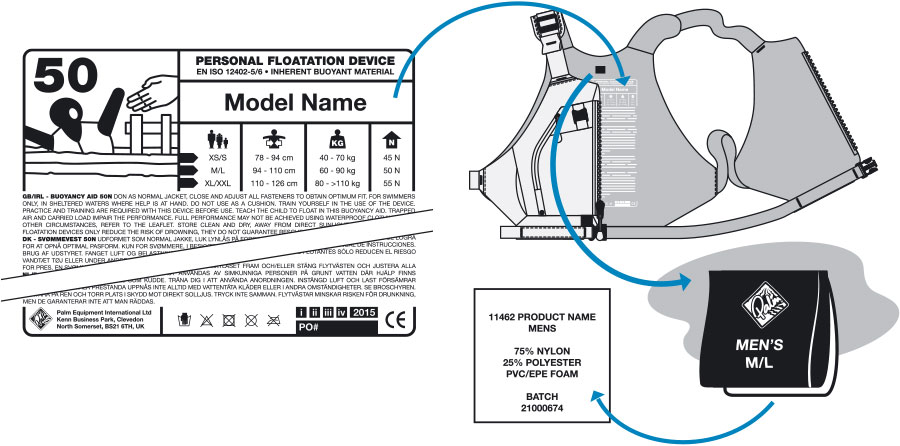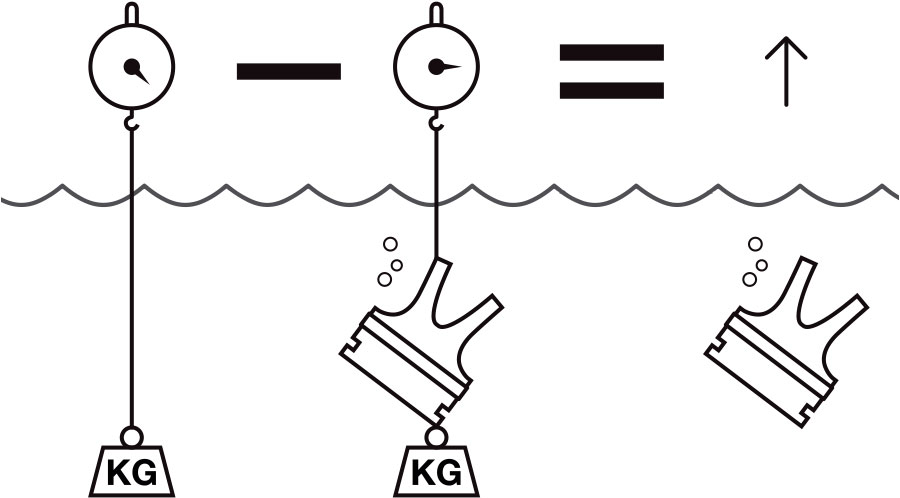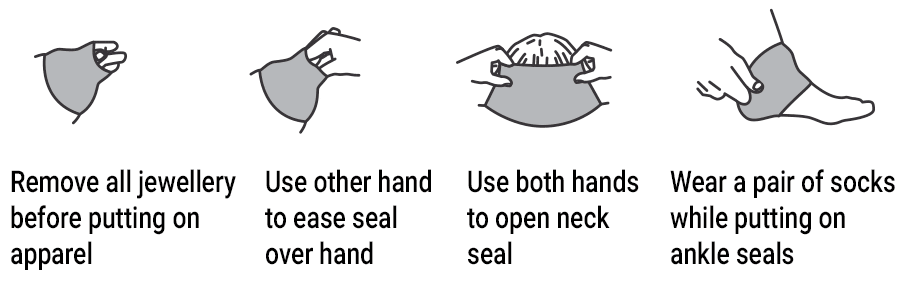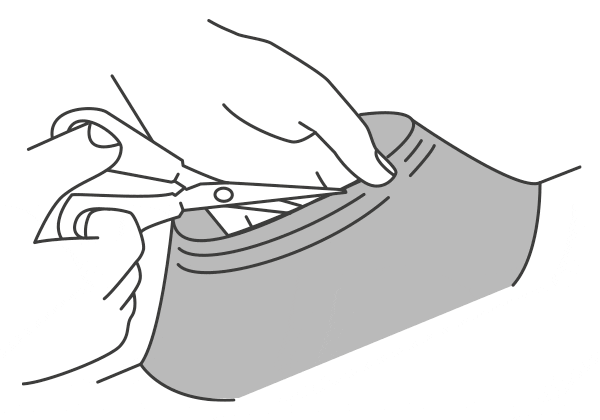Palm Equipment care guides
All gear weathers and wears with use. You’ll find advice in this section on the things you can do to maintain your gear, to keep it working for you. It’s simple to perform most checks every time you use your equipment, and take steps to maintain your gear each time you hang it to dry or put it away. Other checks (like float testing your PFD) or maintenance (like restoring the DWR on your jacket) need only to be done periodically or when you suspect a loss of performance.
CLUBS AND COMMERCIAL OPERATORS – Personal protective equipment (PPE) should be checked regularly for damage or wear and tear. It is important to keep records of purchase, use and testing. You’ll find PDF downloads of our maintenance guides in the sections below.
Personal floatation devices
We make PFDs that exceed ISO standard for buoyancy and integral strength. Our CORDURA® fabric shell PFDs are particularly tough. Look after yours and it will look after you.PFD MAINTENANCE GUIDE DOWNLOAD
PFD MAINTENANCE

Washing – rinse PFDs in clean, fresh water after each use to help reduce corrosion or degradation of materials.

Drying – drip dry PFDs out of sunlight. Frequent forced drying in drying rooms will shorten the lifespan of the material and foam.

Storage – hang PFDs on hangers from the shoulder straps. Avoid storing them wet or damp. Avoid stacking or boxing your PFDs for long periods – sustained compression will damage the foam.
CHECKING PFD CONDITION
A visual check as you pick the PFD from the rail and fit it should be part of every session. Periodically float test it: for light or medium users, we recommend that you should float test your PFDs every year from 3 years after date of purchase; for heavy users we recommend beginning annual float testing after 2 years. If a product does not pass any of these checks below it should be sent to Palm for repair or retired. If you find a fault, remove your PFD from use and decide whether to retire or repair it. Call our customer service team for advice or to arrange a repair at a reasonable cost. For warranty claims return your PFD to us for assessment as soon as possible. We advise that you do not perform repairs yourself.
Zips
fastening zips are free from corrosion, free to slide and can be fully opened.
Buckles
buckles have no broken parts, lock closed and open as intended.
Straps
straps are free to slide and webbing is free from tears, snags or unravelling.
Tears/stitching
check for tears in the fabric or broken stitching, especially around strapping and closures.
Pockets
pockets and other storage are free from debris and mould. Ensure they open/close.
Abrasion/wear
check for excessive abrasion that might result in the shell structure of the garment failing.
Fading
check for significant fading, as this may indicate a deterioration of the strength of the materials.
Foam
check the foam fit. If loose, this indicates deterioration of the foam and loss of floatation.
Floatation
perform a float test to determine that the device still provides enough buoyancy to meet the standard.
PFD LABELLING
Palm PFDs are labelled with their size, batch number and rated floatation (old products may be labelled differently). The size is marked on the fabric label inside the back of the PFD and the label beneath shows the product’s name and code, principle component materials and the batch number.
Printed in the back of your PFD is the ISO label, showing the ISO standard to which it is rated, the rated floatation for that size and model of PFD and a guide to fit for paddler size and weight.
Attached to each new PFD is a booklet, which also has marked on the back cover the average rated buoyancy for the PFDs in this batch from the Palm factory, marked in pen on the information chart.

ISO FLOATATION STANDARD
Palm PFDs are made to ISO 12402-5 (level 50 standard) and 12402-6 (special purposes standard), many Palm PFDs exceed this standard. This standard covers a range of weights with 50 N buoyancy for an adult of 70 kg or more. For small people and kid’s PFDs this scale applies:
| Wearer’s weight (kg) | 30-40 | 40-50 | 50-60 | 60-70 | >70 |
|---|---|---|---|---|---|
| Minimum buoyancy (N) | 35 | 40 | 40 | 45 | 50 |
SIMPLE FLOAT TEST
To test your own PFDs you will need: a hanging scale (electronic luggage scales are good), a short length of rope, a 10 kg weight (12 kg if you’re testing a model with more than 100 N floatation like the Highside Rafter), and enough fresh water to dunk your PFD and weight entirely underwater (a swimming pool or large barrel are ideal).
- Attach your weight to the scale with the rope and dunk it underwater. Take a reading from the scale.
- Attach the weight to your PFD and then to the scale with the rope. Dunk it underwater and wait for any trapped air bubbles to escape. Take a reading from the scale.
- Subtract measurement 2 from measurement 1 to get your PFD’s floatation in kg force. Multiply this by 9.8 to convert kg to Newtons and you have the PFD’s buoyancy in Newtons.

Waterproof outerwear
Our XP fabrics are highly waterproof, breathable and durable. Our garments are made for life on the river or at sea. Nevertheless you can keep your garment waterproof and breathable for longer if you follow a few simple steps:
- When packing your gear away, fold it up loosely and take care not to let latex seals come into contact with abrasive dirt, sand, oil-based substances, sunscreen or insect repellent.
- Try not to leave your gear in a damp condition for long periods.
- Hand wash at a maximum temperature of 30 °C. Garments without large waterproof zips can be machine washed on delicate setting (see the garment label or product page).
- We recommend washing with Granger’s Performance Wash detergent.
- We also recommend you spray the outside of your garment with Granger’s Clothing Repel to renew the DWR.
- Do not tumble dry. Hang your gear to dry naturally out of direct sunlight.
- Once dry, check to see if any repairs are necessary (we provide an excellent repair service).
- Store in a cool, dry place away from sunlight.
- Don’t pile your gear high, or stuff if all back into one bag. Avoid compressing your gear.
 |  | |
| Delicate machine wash 30 °C | Drysuits, hand wash 30 °C | Don’t dry clean |
 |  |  |
| Don’t bleach | Don’t tumble dry | Don’t iron |
Latex seals
Look after your neck, wrist and ankle seals, if you want to keep the water on the outside! Latex seals are not 100% watertight. Movement will always cause a minor amount of seepage, but this is usually insignificant and should not affect your comfort. Due to their vulnerability, no guarantee can be given on latex seals once the garment has been worn.
EVERY TIME YOU USE YOUR JACKET, TROUSERS OR SUIT
- Remove watches, rings and jewellery. Gently place your hand and wrist inside the seal and with your other hand ease each seal on one at a time.
- If there are neck or cuff protectors on your jacket, check that the velcro is not firmly closed when you try to put it on.
- Use both hands for the neck seal. Gently stretch the aperture to allow the seal to pass over your head.
- Finally, remove any excess air from the paddle top by venting the neck with two fingers.
- Take just as much care when removing your paddle jacket; follow the reverse steps dressing and undressing.
- For trousers with latex ankle seals, wearing socks while you put them on can ease the seal on and then you can remove the sock.
- We recommend using a silicone protectant (eg McNett Seal Saver) to extend the life of your seals.
- Natural latex seals are sensitive to sunlight and also vulnerable to damage from oil based products, sunscreen and insect repellent.

TRIMMING LATEX SEALS
The size of the latex seals are related to the size of the garment. Should a seal feel excessively tight it is possible to achieve a custom fit by carefully trimming the seal with sharp scissors – neck seals have concentric rings as a guide. Take care not to trim too much – ideally, you should wear the garment outdoors in cold weather to assess the size required before deciding whether to trim your seals.

Throwlines
The bag, closure, rope and knot are all important for a successful rescue, but a throwline that misses the mark, gets tied in knots or stays at home is of no use. Practice with your line and carry it with you. Be familiar with the parts of your throwline and keep it in good condition.THROWLINE MAINTENANCE GUIDE DOWNLOAD
THROWLINE MAINTENANCE

Washing – rinse your throwline in fresh water to remove mud or grit.

Drying – drip dry your throwline with the rope in loose coils, out of the bag.

Storage – store your throwline in a dry place, either hung in coils or packed dry in the bag.
CHECKING THROWLINE CONDITION
Before you use your throwbag for the first time, unpack, re-pack and test throw it. Make a visual check each time you use or repack your throwline. We recommend that you should carry out the checks below. If a product does not pass any of these it should be repaired or retired.
Attachment
empty the rope from the bag and check that it is tied correctly into the bag.
Sheath
pass the length of the rope through your hands while coiling to check for damage to the outer sheath of the rope, if the strands are frayed or cut.
Core
check to see if the white core is visible at any point along the length of the rope and the rope is uniformly flexible.
Contamination
check the rope and bag for discolouration and smell (eg dirt, grit, fuel).
Closure
check that the draw cord or clip opens and fastens easily and stays closed.
Knots
while repacking, flake the rope in handfuls into the bag and remove any other knots in the rope.
Fading
check for significant fading, as this may indicate a deterioration of the strength of the materials.
THE CLEAN LINE PRINCIPLE
Ropes and moving water can be a dangerous mix, as they sometimes get snagged or tangled during the course of a rescue. There should be no knot or loop at the end of the rope furthest from the bag to ensure that the rope is releasable. We’ve eliminated all unnecessary knots or loops in the throwbag rope and kept any loops too small for a hand or wrist to fit through. Palm throwbags have a Quickclip attachment point which can be detached from the rope if required and is very easy to clip a karabiner to.
KNOTS AND BREAKING STRAIN
Please bear in mind that tying knots in the rope will reduce its strength and can lower the breaking load by as much as half.
CHECKING YOUR THROWBAG KNOT
The rope inside our bags is fastened to the Quickclip webbing with a rethreaded figure of eight, so you can remove and reattach the bag whenever you need to. It’s a good idea to periodically check that the rope is well knotted into the bag with a well dressed knot and an adequate tail.
Waterproof zips
Palm use the best waterproof zips in our pants and suits. Take care of your zip to ensure that the teeth stay aligned and the zip functions smoothly.
- The zip is susceptible to damage when it is only part undone. Keep your zip fully open or fully closed.
- Keep the zip flat and straight when folding or storing your garment. Don’t fold the garment across the zip as this can break the teeth.
- Rinse zips with fresh water after use, especially after use in salt water.
- Check your zip for sand or dirt every use.
- Lubricate your zip periodically with beeswax or a silicone lubricant, like McNett Max Wax, for BDM brass coil zips; TiZip silicone grease for plastic MasterSeal zips; or YKK Ziptech lubricant for AquaSeal zips.
- If the zip jams, try to release it by thoroughly washing in fresh water and applying lubricant. After releasing the zip, gently run the slider back and forth to spread the lubricant along the length of the zip and protect it from future jams.
- Store your garment rolled up. Avoid folding or compressing your zip.
- BDM brass coil zips: store the garment with the zip open.
- TiZip MasterSeal zips: store the garment with the zip closed.
- YKK AquaSeal zips: store the garment with the zip closed.
